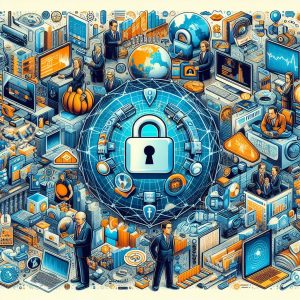I. Introduction
A virtual private network (VPN) refers to a service that establishes an encrypted connection over a public network, allowing users to access the internet more securely and privately. The concept behind VPN technology has existed for decades, but VPNs have become especially important today in helping protect online data and activity.
The origins of VPNs trace back to 1990s tunneling protocols that connected remote offices and users to a central corporate location. Since then, VPN use cases have expanded vastly alongside advancements making internet access widely accessible globally. Their role continues growing as the prominence of privacy vulnerabilities and data misuse allegations shed further light on the importance of encryption.
II. Early Development of VPNs
A. Pre-1990s: Origins of VPN technology
The foundations of virtual private networking technology emerged alongside advancements in data tunneling and encryption in the 1980s and prior. As public networks began transporting sensitive information between connected entities over inherently insecure channels, the necessity for data security mechanisms came into focus.
Early VPN predecessors operated predominantly on a site-to-site basis – allowing branch offices to tunnel into their organization’s wider network privately or enabling remote access to internal tools and platforms securely from outside corporate firewalls for traveling or off-site employees.
Government and military networks helped drive many foundational innovations around virtual networking given the high stakes secrecy demands. Advanced Research Projects Agency Network (ARPANET), an early precursor to today’s public internet itself, laid vital groundwork in studying how to construct protected pathways for remote data transfer or access.
Meanwhile concepts like the Diffie-Hellman key exchange opened new doors for practical, reliable encryption between parties, which serve as elemental building blocks permitting private tunneling today.

B. 1995: Introduction of key VPN protocols
By the mid 1990s, several pivotal virtual private networking protocols and technologies emerged as direct precursors enabling much wider commercial VPN adoption:
PPTP – The Point to Point Tunneling Protocol, introduced in 1995, represented one the first major standards providing user-level client software for personal VPN access. Its relatively simple setup made remote employee access and early “telecommuting” arrangements practical.
L2TP – The Layer 2 Tunneling Protocol arrived as an upgrade over PPTP’s limitations, further standardizing equipment across vendors for more seamless VPN deployments. Built with ISPs and cellular data networks in mind, it enabled routing whole private networks through public channels.
IPsec – As a collection of open Internet Engineering Task Force (IETF) standards, Internet Protocol Security (IPsec) defined mechanisms for encrypting IP traffic end-to-end. This marked a pivotal leap for VPN viability by providing built-in data security rather than relying on the networks themselves being trustworthy.
C. Use of VPNs by corporate and government entities
During these early phases, VPN adoption remained confined largely within government agencies and large private enterprises to connect remote satellite offices and workers securely to internal private intranets as organizations became increasingly dispersed.
Costly licensing and infrastructure hurdles along with tech sophistication demands of early VPNs limited small to midsize business adoption. However, steadily improving reliability, speed and ease-of-use expanded use cases throughout sectors like healthcare, finance and more.
III. Evolution of VPNs for Commercial Use
A. Late 1990s to early 2000s: Transition of VPNs to commercial services
By the late 90s, VPN technology reached sufficient maturity at scale across hardware and software to enable a wider transition beyond purely private enterprise. Internet service providers (ISPs) and network infrastructure operators began offering VPN access services to individuals and public sector clients.
Smaller organizations leveraged managed VPN services through ISPs to replicate enterprise-grade remote access and site-to-site connectivity without enormous upfront investments into in-house VPN servers and networking expertise.
Meanwhile, early commercial VPN providers also began targeting prosumers, entrepreneurs and technically inclined consumers providing paid tunneling services promising online anonymity and data security.
B. Rise of third-party VPN providers
The explosion of internet adoption and online services surfacing in the 2000s expanded demand for virtual private access tools allowing secure web browsing beyond walled enterprise networks.
Established network infrastructure operators like IBM, AT&T, and Cisco entered the growing VPN services market early on. However, newly founded pure-play virtual private network companies also sprouted in greater numbers – paving the way for today’s consumer VPN landscape.
Swedish service IPVanish launched in 2001 offering VPN tunneled internet alongside file sharing and online gaming-optimized servers, foreshadowing the demand from streaming media and torrenting devotees. US-based Encrypt.me kickstarted in 2013 providing freemium browser VPN extensions implementing then still novel WebSocket encrypted tunnels. Others like popular provider HideMyAss emerged in 2005 explicitly citing bypassing geographic internet restrictions as a use case – a goal that propels many VPN subscribers still today.
C. Growing awareness of the need for online security and privacy
Through the 2000s, public awareness skyrocketed around online privacy vulnerabilities and data security threats at personal and institutional levels alike thanks to repeated high-profile hacking incidents and controversies. As faith in open web safety eroded, so too did mass acceptance around the need for tools like VPN services shielding consumers from prying eyes.
Cases like the 2006 theft of millions private AOL search records reminded the public their personal information lacked protections previously assumed. Similarly, discoveries around expansive US government mass surveillance programs monitoring citizens’ internet activity unveiled in 2013 by ex-NSA contractor Edward Snowden fueled reservations globally around unchecked data harvesting happening secretly online.
Cyber attacks like 2016’s Mirai botnet takeover of Internet of Things devices to conduct massive distributed denial of service (DDoS) attacks also exemplified the mounting stakes cybersecurity now carried when even home consumer devices readily fueled such disruptive incidents.
Each successive breach and eye-opening revelation around digital vulnerabilities compelled more consumers to proactively leverage protective tools like VPNs warding off malicious actors online.

IV. Impact of VPNs on Online Privacy and Security
A. Mitigating Internet censorship and hacker threats
Early individual-focused VPN pioneers pitched anonymity merits allowing internet users in restricted regions to bypass filters, blackouts or monitoring imposed by authoritarian state agencies and ISPs. In this way, VPN Liberty Shield promoted unfettered access abroad to news and open communications by tunneling through censorship like China’s Great Firewall.
Likewise growing numbers of security experts pointed to VPN encryption as vital safeguard against cybercriminal efforts to intercept sensitive personal or enterprise data in transit online. Encrypted VPN connections protect vital traffic against man-in-the-middle attacks, WiFi packet sniffing or other data interception techniques still regularly leveraged across the criminal hacking landscape today.
B. Protection against data mining and targeted advertising
In addition to state authorities and underground cyber gangs, revelations also surfaced around the pervasive monitoring and data harvesting conducted by private web and advertising giants like Facebook, Google and others to enable ever-more targeted advertising.
By masking a user’s true IP address and location, VPN technology limited firms’ ability to continue aggregating extensive behavioral advertising profiles based on browsing habits – providing refuge for consumers feeling increasingly surveilled through daily internet use.
C. Role of VPNs in safeguarding online identity
Ultimately for both security and privacy goals, VPN services furnish vital tools that help shield sensitive personal or institutional information from abuse or exploitation by allowing anonymous, encrypted digital connections denying access into private online activities or traits.
Much like physical world privacy protections such as tinted glass discouraging snooping eyes, VPN constructs similar safeguards restricting visibility virtually that serve as fundamental enablers of secure communications and commerce foundational to modern life.
V. Technological Advancements in VPNs
A. Development of more robust encryption standards
Early VPN infrastructures leaned heavily on now dated SSL, 3DES and basic AES encryption methodologies replaced today by much stronger algorithms like RSA-4096, SHA384, and military-grade AES-265 raising the complexity exponentially for codebreakers to crack modern VPN cipher suites. Integrated Perfect Forward Secrecy configuration, using one-time keys protecting past communications from future compromise balanced with Elliptic Curve Diffie-Hellman key exchanges speed up VPN encryption processes to remain highly responsive in consumer applications despite the heavy security protections.
B. Expansion of VPN services for individual users
On the user experience front, VPN providers stressed enhancing ease-of-use, broad platform support, and streamlined client apps to lower barriers allowing less tech-savvy consumers benefit from secured connectivity alongside installations across entire enterprise infrastructures.
One-click connect features, automated network switching responding to new WiFi connections and enabling system-wide connectivity beyond individual device clients all helped popularize VPN usefulness for everyday browsing – not solely as a tool for IT professionals. Similarly expanding support across Windows and macOS PCs, iOS and Android mobile devices, routers, streaming media players and internet of things gadgets opened VPN-protected connectivity across everyday connected environments as threats to household smart devices soared as well.
C. Integration of VPN technology into various devices and platforms
Recognizing usability roadblocks still inhibiting mainstream secure protocol adoption online, major platforms themselves also began directly integrating VPN and encryption technologies tailored for their environments. Apple notably introduced secure network proxy extensions allowing administrators easily established protected network gateways guarding iOS traffic systemwide. Not to be left behind, Android also unfurled platform-level VPN functionality simplified configuring encrypted connections similarly for entire device fleets.
Secure web gateway configurations through VPN likewise featured as standard workplace data protections in cloud collaboration solutions like Microsoft SharePoint and Teams to meet heightened enterprise security regulations. Whole operating systems also sprang up taking privacy-first approaches. Most visible among them – Purism producing Linux-based PureOS for desktop and mobile anchored in biosynthesis design principles centralizing system encryption.

VI. Future Trends in VPN Technology
A. Potential challenges and opportunities for VPNs
Today, VPN ecosystems stand healthier than ever thanks to accessible solutions, massive consumer awareness and proven technology mitigating known risks. However, substantial work remains building integrity around trust and accountability among providers against opaque logging practices or misleading security claims still encountered periodically despite maturing standards. Resource concentration among relatively few large players also risks market capture dynamics eroding competitiveness. However regulatory moves such as India’s personal VPN exemption licenses drive greater legitimacy around personal VPN use signaling positive future precedents abroad still.
B. Emerging innovations in VPN protocols and infrastructure
As barriers fall further propelling VPNs into the technology fabric of smart homes and mobile first lifestyles, advances also continue progressing functionality itself. Wireguard implementation brings lean yet fast VPN performance even across 5G and fiber connections. Scrambled wire-like Multipath VPN configurations spread traffic across multiple pathways dynamically to foil traffic analysis attempts targeting centralized VPN resources. Efforts bridging blockchain-based distributed identity management and anonymizing proxies hint too at decentralized visions securing communications without singular chokepoints.
C. Projected role of VPNs in the evolving digital landscape
Looking ahead, VPNs remain positioned prominently amid continually evolving privacy and security online thanks to flexible nature and simplicity balancing individual interests against modern data harvesting realities. While threats morph, purpose-built encrypted traffic wormholes satisfy core human desires around selective anonymity despite intersectional digital governance concerns. Much as eyeglasses evolved vision correction accommodating humanity’s early information mediums like books, so too will VPN frameworks elevate finding harmony between privacy and transparency fit for emerging augmented age ahead.
Conclusion
From tentative first steps shielding early enterprise networks, virtual private network technology has progressed enormously in scope and accessibility over 30 years maturing into reliable consumer privacy tools used by millions daily alongside remote workforce enablement. VPNs help restore balance between open access and personal controls sorely missing before across today’s data driven internet. Despite challenges ahead, their facilitation of secure communications amid dynamic regulatory environments will only expand importance further across our increasingly connected age. Much as physical locks endure securing homes century after century by blocking unauthorized access, so too will virtual private networking furnish metaphorical keys selectively unveiling individuals’ digital lives on their own terms.